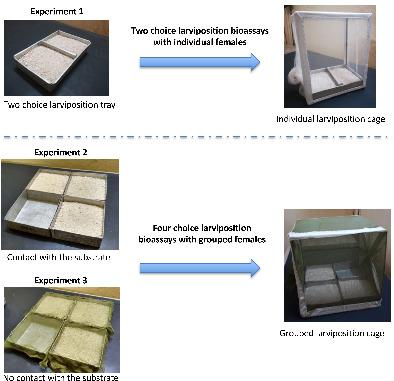当前位置:
X-MOL 学术
›
Ecol. Entomol.
›
论文详情
Our official English website, www.x-mol.net, welcomes your
feedback! (Note: you will need to create a separate account there.)
Larviposition site selection mediated by volatile semiochemicals in Glossina palpalis gambiensis
Ecological Entomology ( IF 2.0 ) Pub Date : 2020-10-16 , DOI: 10.1111/een.12962 Gimonneau Geoffrey 1, 2, 3 , Romaric Ouedraogo 1 , Salou Ernest 1, 4 , Rayaisse Jean‐Baptiste 1 , Bruno Buatois 5 , Philippe Solano 2, 3 , Laurent Dormont 5 , Olivier Roux 6, 7 , Jérémy Bouyer 2, 3, 8, 9
Ecological Entomology ( IF 2.0 ) Pub Date : 2020-10-16 , DOI: 10.1111/een.12962 Gimonneau Geoffrey 1, 2, 3 , Romaric Ouedraogo 1 , Salou Ernest 1, 4 , Rayaisse Jean‐Baptiste 1 , Bruno Buatois 5 , Philippe Solano 2, 3 , Laurent Dormont 5 , Olivier Roux 6, 7 , Jérémy Bouyer 2, 3, 8, 9
Affiliation

|
1. Tsetse flies (Diptera: Glossinidae) are K‐strategist species and deposit a single larva at 10‐day intervals in specific sites. As larviposition site selection strongly impacts reproductive success, the selection of larviposition sites is unlikely to be random and will be subject to strong selective processes, probably mediated by specific cues. 2. This study was designed to assess the existence of an aggregation effect in the palpalis group and to test its potential chemical nature (contact or volatile compounds). The larviposition site selection of Glossina palpalis gambiensis was studied according to the presence of conspecific and heterospecific larvae (morsitans group) buried in substrates. Three sets of experiments were performed with either individual or grouped gravid females and with or without physical access to the substrate. 3. In individual larviposition experiments, females were more likely to select trays with buried larvae than unconditioned sand (63.2% and 36.8%, respectively; P < 0.05). In the grouped experiment with substrate contact, females were more likely to larviposit in trays with conspecific (40%) or heterospecific (33%) buried larvae than in unconditioned sand (22%) or empty trays (5%; P < 0.05). The results were similar without substrate contact, but more pupae were deposited in empty trays (19%). 4. These results provide the first evidence for larval aggregation in G. p. gambiensis and suggest that larviposition site selection is mediated by volatile semiochemicals of larval or pupal origin. However, this larval aggregation does not seem to be species specific and therefore offers new options for the behavioural manipulation of these vectors.
中文翻译:

Glossina palpalis gambiensis 挥发性信息素介导的幼虫位置选择
1. 采采蝇(双翅目:舌蝇科)是 K-strategist 物种,每 10 天在特定地点放置一只幼虫。由于幼虫位置的选择强烈影响繁殖成功,幼虫位置的选择不太可能是随机的,并且会受到强烈的选择过程的影响,可能由特定线索介导。2.本研究旨在评估palpalis组中聚集效应的存在并测试其潜在的化学性质(接触或挥发性化合物)。根据埋在基质中的同种和异种幼虫(morsitans 组)的存在,研究了 Glossina palpalis gambiensis 的幼虫位置选择。对单独或分组的妊娠雌性进行了三组实验,并且可以接触或不接触基质。3. 在单独的幼虫定位实验中,雌性比未处理的沙子更有可能选择带有埋藏幼虫的托盘(分别为 63.2% 和 36.8%;P < 0.05)。在与基质接触的分组实验中,与未处理的沙子 (22%) 或空托盘 (5%; P < 0.05) 相比,雌性更有可能在具有同种 (40%) 或异种 (33%) 埋藏幼虫的托盘中产卵。结果在不接触基质的情况下相似,但更多的蛹沉积在空托盘中 (19%)。4. 这些结果为 G. p. 中的幼虫聚集提供了第一个证据。gambiensis 并表明幼虫位置选择是由幼虫或蛹来源的挥发性信息素化学物质介导的。然而,这种幼虫聚集似乎不是物种特异性的,因此为这些载体的行为操纵提供了新的选择。
更新日期:2020-10-16
中文翻译:

Glossina palpalis gambiensis 挥发性信息素介导的幼虫位置选择
1. 采采蝇(双翅目:舌蝇科)是 K-strategist 物种,每 10 天在特定地点放置一只幼虫。由于幼虫位置的选择强烈影响繁殖成功,幼虫位置的选择不太可能是随机的,并且会受到强烈的选择过程的影响,可能由特定线索介导。2.本研究旨在评估palpalis组中聚集效应的存在并测试其潜在的化学性质(接触或挥发性化合物)。根据埋在基质中的同种和异种幼虫(morsitans 组)的存在,研究了 Glossina palpalis gambiensis 的幼虫位置选择。对单独或分组的妊娠雌性进行了三组实验,并且可以接触或不接触基质。3. 在单独的幼虫定位实验中,雌性比未处理的沙子更有可能选择带有埋藏幼虫的托盘(分别为 63.2% 和 36.8%;P < 0.05)。在与基质接触的分组实验中,与未处理的沙子 (22%) 或空托盘 (5%; P < 0.05) 相比,雌性更有可能在具有同种 (40%) 或异种 (33%) 埋藏幼虫的托盘中产卵。结果在不接触基质的情况下相似,但更多的蛹沉积在空托盘中 (19%)。4. 这些结果为 G. p. 中的幼虫聚集提供了第一个证据。gambiensis 并表明幼虫位置选择是由幼虫或蛹来源的挥发性信息素化学物质介导的。然而,这种幼虫聚集似乎不是物种特异性的,因此为这些载体的行为操纵提供了新的选择。











































 京公网安备 11010802027423号
京公网安备 11010802027423号